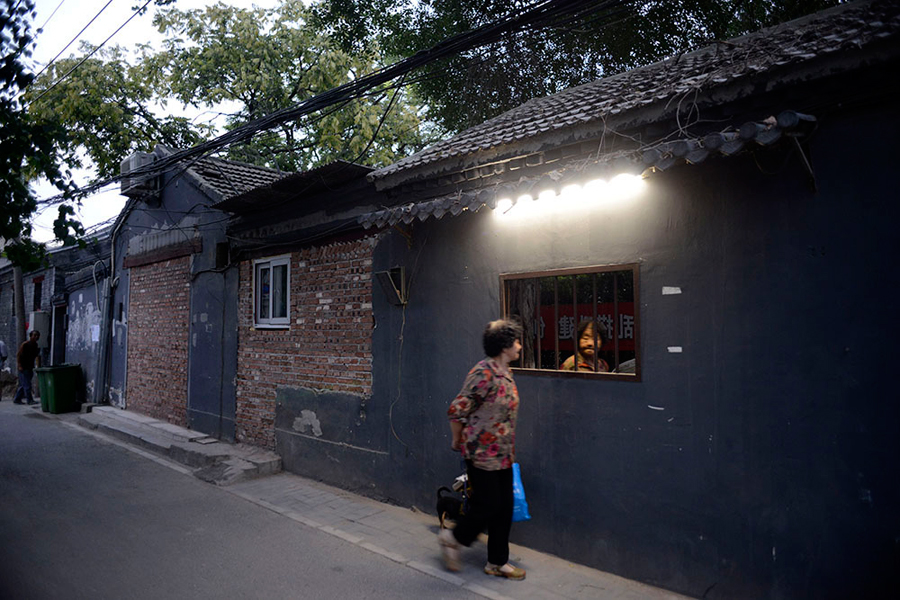Dispatches: Beijing
Following government plans for a greener less-crowded capital, artists are finding themselves squeezed out
Following government plans for a greener less-crowded capital, artists are finding themselves squeezed out

On a recent visit to Arrow Factory, a compact non-profit art space nestled in a central Beijing hutong alleyway, I noticed a striking difference to its façade. Whereas previously you could look into the exhibition space through its storefront patio doors, this has since been reduced to a mere window. The change was the result of Arrow Factory’s summer project, Fences (2017) by Shanghai-based artist Yang Zhenzhong, who sealed up the exterior leaving only a barred window with mirrored glass, behind which was hidden a video camera that recorded visitors’ interactions with their reflections. The video feed was displayed on a monitor in Wu Jin – a small bar run by the curators – just a few doors away. Yang’s work ended up being more prescient than he intended. Just a few weeks after his show’s opening, storefronts up and down the hutong and all around the neighbourhood were bricked up by the authorities, leaving only a window for their businesses to operate, eventually forcing most of them, including Wu Jin, to close.

For the foreseeable future, all subsequent projects at Arrow Factory will have no choice but to operate like their neighbours, through a window. A notice issued by a collective of six different government bodies explains the sudden change as an enforcement of eight separate laws and regulations overseeing everything from health and safety to architectural integrity in order to: ‘protect residents’ legal rights, preserve the dignity of the capital, eliminate safety concerns, administer environmental order, and create a pleasant living environment.’ Near to Arrow Factory, a poster features a rendering of hutong facades after this ‘environmental renovation’ has been completed, with the idea of restoring the hutongs to their original state.

Government regulations regarding population control in the capital reveals another layer behind this drive. In April, Beijing’s municipal government announced it would cap the population at 23 million by 2020, which can only be achieved by driving out many of its migrant residents. Migrants from other parts of China run a significant proportion of the capital’s small businesses. According to a report in the Financial Times, 30 million square metres of small shops, restaurants, and fruit stands deemed to be ‘illegal construction’ were torn down last year, with a further 40 million square metres marked for demolition this year. These are not in the picturesque city-centre hutongs mentioned above, but rather in the so-called ‘rural-urban fringe’ areas where migrants find cheap housing and business premises on the outskirts of Beijing.

It is precisely in these peripheral zones that artists have built many of their studio complexes – the best-known districts include Huantie, Feijiacun, Yihaodi and Caochangdi – where land has been available and relatively affordable, and where there are plenty of workshops for art-related production facilities. However, as none of buildings in these areas are legal, the very nature of such places is temporary. Warehouses and artist studios are built without permits, and their cheap prices and relative proximity to the city compensates for a lack of stability. Landlords still draw up rental contracts to give artists the appearance of some assurance. But while these might deter the landlord or artist abusing each other’s trust, they cannot confer any legal status to the actual studios. When local authorities need the land for any other purpose, they can move in without any legal obstacle.

There have been several instances of forced evictions of artists in the recent past, resulting in varying degrees of protest. One extreme example came in February 2010, when the art districts Zheng Yang and 008 to the north of the city were swarmed by armed thugs beating artists into submission while demolition teams waited to move in – it made international news. The thugs dispersed as soon as the police arrived on the scene, but not in time to save the artists’ studios. Most violent evictions come at the instigation of private developers taking over land occupied by artists for real estate projects, although it is unclear who was behind an incident this year in Caochangdi, where members of the curiously named Iowa Co-op were forcibly evicted and their studios destroyed. More recent clearances have been government projects where there have generally been lengthy periods of notice for people to move out, including the demolition in April of Hei Qiao (Black Bridge), a village in which many prominent artists such as Zhao Gang, Sun Xun, and Liang Yuanwei had their studios.

The broader picture behind these events can be glimpsed in a major new plan to restructure the city, published by the government on 29 September, parts of which relate to city’s ambitious anti-pollution drive and population cap. The plan also aims to reduce the amount of land for construction and increase green land quite substantially, meaning that many of those areas skirting the city such as Black Bridge village are to be transformed into the city’s green belt. Hand in hand with such policies, the plan aims to ‘remove non-capital functions’ such as manufacturing and industry from the city.
The severe new anti-pollution regulations have the effect of amplifying these limits on ‘industry’, meaning that everything from welding to spray painting has largely been banned in Beijing altogether. This has exacerbated troubles for some artists who have already been forced to move their studios much farther from the city, because much of their work involves such techniques. While the new plan for Beijing looks impressive on paper, its brutal implementation leaves much room for improvement. Perhaps there’s a note of irony then, in the plan’s stated ambition for the capital to be reserved as ‘a national centre for culture.’
Main image: A hutong in Beijing. Courtesy: wsquared Flickr























